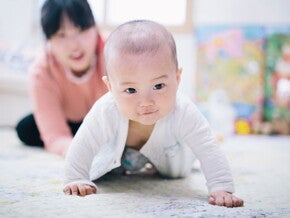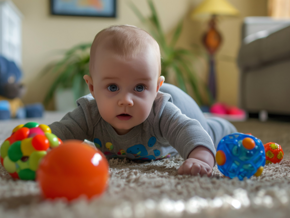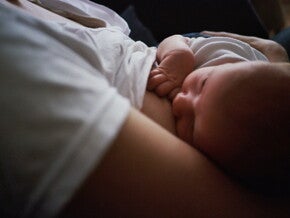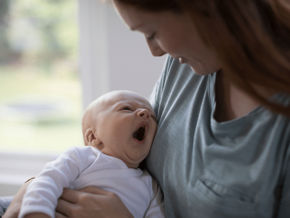
Baby Toys & Games
You and the immediate environment are your baby’s best toys. Everything is new to them and it takes time to process and feel comfortable with new and natural sounds, smells and feel.
Once your baby reaches 6 weeks old they will be wanting more stimulation. Suitable toys would be soft rattles, mobiles to focus on, crackle sounding cloth toys, soft and smooth textured toys and YOUR face. YOU are still your baby’s best toy. Your baby will love people talking to them and making faces with them. Read and sing to your baby and let them lie on your tummy to play and gently rumble.
6 weeks to 6 months
Your baby can get over stimulated or confused by seeing too many toys all at once. Put some away and rotate them so there always seems to be something new every few days or so. Try to dial down the stimulation about 30 minutes before they are due to have a sleep – this will calm the brain activity, making it easier for your baby to settle and sleep. Suitable toys while awake include absolutely anything that is safe and stimulates their inquisitive nature to enhance their growth and development. Here are some ideas:
See and watch
- Keep mobiles and toys slightly out of reach to ensure safety and encourage reaching and stretching;
- Use bright colours and shapes;
- Hold objects about 20cm from your baby’s face, move side to side, up and down;
- Lay baby on their tummy and raise a toy to encourage head movement;
- Let your baby look in a mirror;
- Take time to observe objects together that move both inside and outside the home.
Hear and speech
- Talk, sing, read and hum together;
- Vary sounds from loud to soft, high to low, short to long;
- Try rhyming games, books and songs;
- Make sounds, coughs, or babbles back to your baby with a smile in an interested tone.
Touch and feel
- Look at books together with textures made from different materials;
- Expose your baby’s feet to different surfaces such as grass, water, sand, smooth tiles and soft carpet;
- Let them touch your face and hair;
- Lay them on a silky smooth or different textured surface.
Taste and smell
- Allow your baby to sniff and smell household cooking and food aromas;
- Smell garden flowers.
Balance and movement
- Cuddle, sway and roll together;
- Go for walks in a sling or stroller;
- Bounce your baby gently on your knee.
Developmental activities 6 –12 month olds
If you have a lot of toys on display, pack half or a third away in containers and rotate the containers each week or every few days depending on how much time you spend at home. This makes activities and toys new and exciting over and over again. Remember to allow time for your baby to discover the environment and everyday items. Here are some ideas:
Taste and smell
- Offer an increasing variety of appropriate foods. Vary the texture and the taste;
- Give your baby the opportunity to smell the tantalising aromas that waft from the kitchen as the evening meal is prepared (even if it is only baked beans on toast);
- Smell the flowers and herbs in the garden.
See, watch and touch
- Provide floor time with toys slightly out of reach;
- Allow inside and outside play on a mat with a variety of toys. Expose their bare feet to different safe textured surfaces such as cement, grass, sand, water, dirt and pebbles.
Hear and speech
- Rubbing and patting games and songs such as ‘Pat-a-cake’, ‘Round and round the garden’;
- Read a variety of books including rhyming ones and ones with noise buttons;
- Talk about anything and everything when out shopping, visiting or walking;
- When your baby makes a sound, cough, or babble make it back with a smile in an interested tone;
- Once your baby can sit up, read bath books during bath time;
- Look at family photo albums or scrap books together.
Reaching, posting and tipping
- Have available fun safe objects in an open container. Your baby will enjoy this activity when they can sit unsupported. Allow time to search through the container or box and turn it over;
- Have a removable lid with a large cut out hole allowing toys to be posted back in;
- Dangle toys on the stroller or across a chair leg when your little one is lying nearby to encourage kicking and reaching.
Sound and music
- Plastic juice bottles filled with bits and pieces and a firmly taped on lid makes for wonderful sounds;
- Make noise with a bell or drum when your baby is not looking;
- Walk on the beach or in the bush and listen to the sounds of silence;
- Play music of all varieties and volumes. Include saucepans and plastic containers;
- Expose your baby to natural everyday sounds – this may mean avoiding having the television or radio constantly playing in the background.
Hide and seek or peek-a-boo
- Hide yourself or hide an object under or behind something;
- Praise your baby when they successfully find it.
Chasing
- Crawl after your baby taking your time to catch up or have them crawl after you and catch you.
Tug of war
- Have a scarf or tea towel just out of reach, when your baby takes it, gently tug on it and if they make an effort to hold on let them have it to play with.
Cups and blocks
- Let your baby pile them, push them, stack them, crash them, roll them, and put things in them.
Rolling and tumbling
- Hold your baby laying over a fit ball, first on the front and then on the back and gently rock and roll;
- Sit on a low chair and encourage your baby to roll down the gentle incline of your legs positioned straight out in front of you;
- Cuddle her while you are lying down and gently roll from side to side.
Enjoy spending time exploring and learning together, these precious times when they’re so intrigued by everything you do won’t last forever!


















